 |
|||||||||||||||||
Soaring at the Cosmosphere A Conversation with Jim Remar President and CEO Cosmosphere International SciEd Center & Space Museum by Michelle Evans, June 2019
XXXThe Cosmosphere in Hutchinson, Kansas, is a uniquely-placed space museum. Unlike other museums of its kind, it is not near a major metropolitan center, nor is it located in a spot where something significant happened in the history of space exploration. To get there, you have to want to go there. And it’s worth the trip. It exists primarily because of the vision and drive of one person, Patricia Carey, who laid the foundation of what would become the Cosmosphere in 1962. XXXXXXCosmosphere is considered a must-see museum by anyone interested in and excited by space exploration. It is one of the world's premiere space history museums, rivaled primarily by the Smithsonian National Air & Space Museum in Washington, D.C., and the National Museum of the U.S. Air Force in Dayton, Ohio. XXXXXXWhen you arrive, you can’t miss the Mercury Redstone nestled at the apex of the entrance building, or the Gemini Titan off on the west side, with a Saturn V’s mighty F-1 engine you can stroll beneath in between. As you walk to the entrance, you are greeted by a life-size sculpture of Apollo 17 astronaut Gene Cernan at the moment he was ready to lift the final human foot off the surface of the Moon at approximately 12:45 am on Thursday, 14 December 1972. Heading inside, a giant SR-71 Blackbird seems to swoop down from the sky to meet you nose-to-nose. Behind it is a full-scale replica of the Space Shuttle Endeavour that blends into the back wall. Stepping under the wing of the shuttle, you pick up your tickets to head inside to start your exploration. From this unconventional entrance gallery, you know that this is not an everyday space museum. XXXXXXOn the main level you’ll find the Carey Digital Dome Theater, the Justice Planetarium, and Dr. Goddard’s Lab, along with the Cosmosphere Cafe and Cargo Bay Gift Store. However, to truly start your adventure seek out the stained glass window that echoes a Space Age version of Leonardo da Vinci’s Vitruvian Man. Along the top it intones “Ad Astra per Aspera, To the Stars Through Difficulties.” Beneath that, you’ll descend the stairway to the lower level where you enter into the museum itself. Once there, travel the maze of corridors to follow the history of rocketry and spaceflight. Around every corner is something amazing and thought provoking. Arrive early to give yourself plenty of time, and definitely consider a multiple-day exploration to cover all the nooks and crannies. XXXXXXMy first excursion to the Cosmosphere was in late May 2006 as part of a massive cross country trip where I did the last of my interviews and research prior to writing my book “The X-15 Rocket Plane, Flying the First Wings into Space.” This time around I wanted to delve more deeply, so I contacted their Public Relations Coordinator, Carla Stanfield. Arrangements were made for a whole day of interviews to cover all aspects of the Cosmosphere. Unfortunately, a hectic schedule and bad weather along the road left Cherie and me susceptible to health problems, so we had to truncate our plans somewhat when we arrived in Hutchinson. We still were able to thoroughly tour the museum, and also to do our interview with Jim Remar, President and Chief Executive Officer of Cosmosphere. What follows is a transcript of our fascinating interview, along with a few notes to bridge the gaps along the way
Background
Michelle Evans: Good afternoon. Could you give me a bit about your background and why you are here at the Cosmosphere?
Jim Remar: I’m the President and CEO of Cosmosphere. I’ve got a double major in History and Political Science from Washburn University [Topeka, Kansas]. I have a Masters in Museum Administration from the University of Nebraska, and a mini-MBA from Wichita State University. I’ve spent most of my career in the museum industry, with the exception of four years when I was Vice President of Operations for Gregory Incorporated. Other than that, I’ve been a museum guy all my life. XXXXXXI grew up here in Hutchinson, so this is a community that is near and dear to me. I moved away in 1990 to go to school, then had my first job running a small historic site in central Pennsylvania. It was a manufacturer of horse-drawn vehicles, of all things, so I joke that I skipped a few modes of transportation from horse-drawn buggies to rockets! In 2000 I had the opportunity to come to Cosmosphere, come back to Hutchinson. I started at Cosmosphere as the Curator in 2008, came back in 2012 as President, and a year-and-a-half ago I was promoted to Chief Executive Officer.
ME: Isn’t it great to come to work and have a Lunar Module sitting here?
JR: It is! A Lunar Module on display; to walk underneath an SR-71. So it’s inspiring to walk in the front doors every day. To know what we’ve accomplished and hopefully what we’ll accomplish next.
ME: Were you here when they were first building Cosmosphere?
JR: I was not. I came in right after the most recent expansion, the largest expansion. That was in 1997. I came on in 2000, so that was after that major expansion. I saw the media and PR that was generated for the Cosmosphere. So I’ve seen some exciting things happen.
XXXXArtifacts and Restoration Work
ME: One of the things that the Cosmosphere is best known for is not only for being one of the world’s premiere air & space museums, but for your restoration work. Can you talk about that aspect?
JR: Yeah, absolutely! We have the largest collection of US artifacts outside the Smithsonian, and the largest collection of Soviet artifacts outside of Moscow. But what a lot of people also recognize us for are our conservation, restoration, and fabrication capabilities. We have long been the industry experts in the preservation and restoration of space artifacts. From Mercury spacecraft to Gemini spacecraft, Apollo spacecraft, we’ve done major restorations, not only Liberty Bell 7, but Gemini 6, Gemini 10, Apollo 12, and Apollo 13. We’ve done the F-1 engines for Jeff Bezos and Bezos Expeditions. Our current project, we are presently restoring the original mission consoles from the historic Mission Control down at NASA’s Johnson Space Center [Houston, Texas].
ME: Is that being done in time for the Apollo 11 50th anniversary?
JR: It is. We started this project about two years ago. We are part of a larger team. [Pauses] You can hear the kids in the background!
XXX[NOTE: Throughout our conversation, there was a lot of background noise as schoolchildren excitedly explored the Museum, its artifacts, and the activities available for them.]
ME: Yes! They’re certainly having fun.
JR: They are, which is great!
XXX[Continuing] We’re part of a larger team which has the objective of restoring the historic Mission Operations Control Center—and bringing it back to life. Bringing it back to as it was when it was utilized during the Apollo era. For years, the control room had been neglected. Many had considered that room to be the cathedral to early manned space exploration. So what we are doing, our team has taken the nineteen consoles in that room, including the Flight Director’s console, and preserving them, removing the corrosion, putting a corrosion inhibitor on them, and then re-animating them; bringing them back to life, so, when the visitors go into the viewing room they’ll be able to see the consoles light up, we’ll see the data, the telemetry on the screens. It’s part of the bigger picture where the carpet, the wall coverings, the ceiling, the lighting, is all being restored. It will essentially be as if the controllers walked out of the room to go to dinner with the intent of coming back. When the visitor sees it, that room will tell a story, it will come to life. It will be as it was when the Eagle put down on the lunar surface.
XXX[NOTE: The restored Mission Control Operations Center was officially re-opened to the public at Space Center Houston on 28 June 2019, about three weeks prior to the Apollo 11 50th anniversary of the first lunar landing.]
ME: Did you have anything to do with the Launch Control Center consoles that were restored down at Kennedy Space Center [Florida]?
JR: We did not. Our team was not involved in the Launch Control Center, nor the replication of the Launch Control. But, fortunately, we have the Mission Control.
ME: It’s really great the way they have it down at the KSC Saturn V Center.
JR: It is. Great to re-create that whole experience. It’s pretty neat.
ME: Then you get to walk out and, ‘Oh, look, a Saturn V!’ So are you going to get a Saturn V here?
JR: I wish! Unfortunately, there are no full Saturn Vs left. Fortunately, we do have an F-1 engine outside, as well as the original F-1 pieces on display from the Bezos expedition.
ME: When are they going to be leaving? They’re going somewhere else?
JR: They are. The pieces that were positively identified from Apollo 11 are the property of the [Smithsonian] National Air and Space Museum. Presently, Air and Space is undergoing a major renovation, so we anticipate that for maybe the next two years we’ll have those on display until they’re ready to take possession.
ME: That’s just such an amazing thing to bring those up from the bottom of the Atlantic Ocean. How far down were they?
JR: Around three miles.
ME: Three miles! Wow. So that’s deeper than the Titanic.
JR: Deeper than the Titanic. Absolutely.
ME: Pretty amazing that they could identify them from a specific engine, from a specific flight.
JR: They had an idea where the debris fields were. In 2011 they sent an expedition out to try and locate the debris fields using side-scan sonar. They were successful in doing so, and in 2012 the expeditions to recover the engines went out. The first time they actually put eyeballs on the target, they dropped the ROVs, the remotely-operated vehicles. They had two of them. They saw the engines, then unfortunately they couldn’t identify what missions they were from on the bottom of the ocean, so they began to pick the most recognizable pieces and brought them up. Then it was our conservation team that was able to identify the engines from their respective missions, including Apollo 11.
ME: Right behind you, you have a Lunar Module. Can you tell me about this specific artifact?
JR: Yeah, absolutely. Sitting behind us is a Lunar Module. Although it is a replica, it was manufactured by Grumman [Bethpage, New York]. Grumman was the company that produced the Lunar Module for the Apollo program, and they built this piece specifically for NBC News to use as a prop during the lunar landings.
ME: So it’s been well used?
JR: It has. Not only did NBC use it, not only is it on display here at the Cosmosphere, it was also one of the main prop pieces in the Tom Hanks-produced movie for IMAX, ‘Magnificent Desolation.’
ME: How many artifacts do you have?
JR: We have about 10-thousand artifacts in our collection, of which, only about seven or eight percent are on display here at the Cosmosphere. We have probably another three or four percent on display at other museums, as well as a few international traveling exhibits that we support. We have a very nice collection of artifacts.
ME: Out of all those artifacts, what is your favorite artifact?
JR: That’s a great question. My favorite artifact has to be the [Apollo Launch Umbilical Tower] White Room. There were three White Rooms, three Umbilical Towers, and just knowing what that White Room was, what it was used for, the emotions that had to be occurring inside that White Room. It’s incredible to step in there and think about what’s going through everyone’s mind as they prepared to launch the mighty Saturn V.
XXX[NOTE: The White Room sat at the end of umbilical arm 9 near the top of the Launch Umbilical Tower. This was also known as the Crew Access Arm. When the astronauts came up the elevator, they exited and walked across the passageway along the umbilical arm to the White Room. In there, they did final preparations before actually entering the Apollo Command Module for their flights to the Moon. One of the last people to see them was Guenter Wendt, the Pad Leader, who made sure everything was perfectly set up for the crew, and that they were safely installed in their spacecraft seats, before the hatch was sealed. The next people to see the astronauts in person would be the US Navy frogmen who opened the hatch after splashdown in the ocean at the end of the mission.]
ME: Now you talked about having only a small percentage of artifacts here on display. Where is everything else kept?
JR: We have three storage locations. We have our primary storage area here in the Cosmosphere. That’s probably where 80 percent of the artifacts are stored. Then we have two off-site warehouses. We have a stand-alone warehouse, then we have another warehouse that’s part of our SpaceWorks restoration facility.
ME: That’s here in town?
JR: All of them are here in town, yes.
XXXLocation, Location, Location
ME: You’re out in the middle of nowhere, so to speak. I’ve mentioned this to Carla [Stanfield, Public Relations Coordinator] so please forgive me for saying it that way.
JR: [Laughs] No worries. We’re off the beaten path. We’re not near any major highways or metropolitan epicenters. We’re a community of 40-thousand people. The fact that we’re here is a testament to our founders and the people who had some foresight, and a lot of ingenuity and a desire to share something spectacular with the people of Hutchinson, as well as the region and nation.
ME: How many people do you get through here each year?
JR: We get about 105-thousand, and that includes our outreach. It’s one of the largest tourist attractions in the state of Kansas. The fact that we’re a small community speaks volumes that over 100-thousand people interact with the Cosmosphere annually.
ME: Do you have any figures on how it affects the economy?
JR: Cosmosphere has about a 12- to 13-million dollar impact on the local economy. We commissioned the University of Kansas School of Business to do a study for what our state economic impact is. They estimate that to be a 103-million dollar impact on the state.
ME: Pretty impressive.
JR: Absolutely. It is.
XXXFounding of Cosmosphere
ME: Now, you weren’t here personally at the beginning, but what can you tell me about the beginnings of Cosmosphere?
JR: We started out as a small planetarium. Patty Carey was our founder. For those familiar with Hutchinson, we sit on one of the largest natural deposits of salt in the country. So Patty’s family, that she married into, were major producers and miners of salt. Patty had a lifelong love of the stars, and she wanted to do something to share that with the community, so she raised the money to purchase a used star projector and a used dome, and set up her planetarium in the Poultry building on the [Kansas] State Fairgrounds. From there, it grew and came onto the campus of Hutchinson Community College in 1966. In fact, our Doctor Goddard’s Lab is Patty’s second-generation planetarium. XXXXXXIn 1980, we opened as the Kansas Cosmosphere and Discovery Center. It was about a 35-thousand square-foot facility with, I believe, the eighth Omnimax Theater domed presentation in the world. [Omnimax is the domed version of IMAX.] XXXXXXAll this was because Patty wanted to do something for science and science education in the community. There were such centers in major metropolitan areas on the coasts, but nothing servicing this geography of the United States. So Patty said, ‘Why not Hutchinson?’ She was able to work with our first CEO Max Ary, and acquired a significant number of artifacts from the US program. Over the years, we acquired additional artifacts, including artifacts from the Soviets, then continued to expand and grow into what we are today.
XXXSoviet Collection and Max Ary
ME: You have the biggest collection of Soviet artifacts?
JR: We have the largest selection of Soviet [artifacts] outside of Moscow. Which really puts the Cosmosphere in the position to tell the definitive story of the space race from both points of view. We’re really the only museum in the world that is able to do that.
ME: The capsules and the suits and those sorts of things, you don’t normally see.
JR: Absolutely.
ME: You did mention Max Ary. If I may go there, please tell me about what happened.
JR: Max Ary was the first CEO of the Cosmosphere. He was responsible for the collection that we have today; responsible for the facility that we know today, as well as the Museum. He did tremendous work developing and growing the Cosmosphere into the world-renowned organization that it is. Unfortunately, he decided to sell some artifacts that were not of his belonging for his personal gain, and the rest is history.
ME: How long ago was that?
JR: It was discovered in 2003.
XXX[NOTE: Max L. Ary was convicted by a jury on 1 November 2005 of mail and wire fraud, theft of government property, transportation of stolen property, and money laundering. The verdict was appealed, but Ary lost the appeal, requiring him to report to the Federal Correctional Institution at El Reno, Oklahoma, on 24 April 2008. He served 777 days of a three-year term. Ary’s sentence also included three years of parole and the payment of $132,374 in restitution for the artifacts that were deemed not his property to sell.]
ME: Is anyone at the Museum in contact with Ary anymore?
JR: The Museum has actually done work for the [Thomas P.] Stafford [Air & Space] Museum [where Max Ary is now Executive Director]. The Gemini 6 capsule is on display at the Oklahoma History Center, and they and the Stafford Museum agreed, along with the Smithsonian (the Smithsonian owns the spacecraft), to send the spacecraft to Weatherford, for the Stafford Museum. Stafford commissioned Cosmosphere (SpaceWorks) to oversee the move and installation of that spacecraft there in Weatherford, Oklahoma.
ME: We were just there a few days ago. That museum blew me away. I did not expect what I saw there at all. It was very, very good.
XXXEducational Programs and Cosmosphere Camp
ME: Everything the Cosmosphere touches really takes off.
JR: It does. We not only have a tremendous museum, but we have a wide range of education programs, so those have allowed us to have a tremendous impact across this country. Last year we had 39 states represented in our Cosmosphere Camps program. Many of our former campers and counselors have gone on to NASA, the aerospace industry, or the military. We have one of our former campers who’s a mission controller at JPL [NASA’s Jet Propulsion Lab in Pasadena, California]; along with people working at SpaceX and down at Johnson Space Center. It’s inspiring to see these kids, then to follow them and keep track of where they land as professionals.
ME: Getting kids excited about space is so instrumental to, not only the future, but exciting their minds. About how many kids do you have going through here each year?
JR: In terms of school field trips, we do about 12-thousand kids annually. Then, with our camp programs, we do a little over 11-hundred over a 12-week period.
ME: Tell me more about your camp programs.
JR: We have a variety of camps starting out for kids in early elementary, all the way up through high school. We begin introducing kids about planet Earth, about Mars, about investigating space; and then our flagship programs are 101 through 501. XXXXXXFor 101, the kids come and it’s an in-residence camp, where they stay at the dorms at the community college. We walk them through various training sessions, and we work them through various components. We teach them about teamwork, leadership, cooperation, and critical thinking. It culminates their activities by flying a mission on a motion-based simulator which is [Space] Shuttle-based. In Level Two they progress from there, they expand about what they learned in Level One. We also introduce a scuba activity, like what the astronauts do in their training in the Neutral Buoyancy Laboratory. Then, in 301, we take our kids down to Houston and Johnson Space Center to give them a behind-the-scenes tour, and let them interact with actual engineers down at NASA. In 401, they go to Kennedy Space Center and have the same type of experience. Then in our final one, we take them out to California, and take them to SpaceX and the Jet Propulsion Lab. We take them to Edwards Air Force Base and the California Science Center to teach them about what is possible. XXXXXXWe also have an Adult Astronaut camp that allows the adults to act like children and get into the simulators and get to do the activities that the kids would. They typically have a blast! It allows them to re-live their childhood, live their dreams!
ME: You mentioned ‘simulators.’ Please tell me about your different simulators.
JR: Up in our camp area we have what we call our [Space] Shuttle-based simulator. It’s about three-quarters to scale to the Shuttle cockpit, and it’s motion-based, so it pitches up and down, has subwoofers underneath that rumbles to replicate launch and reentry. The kids are literally flying a mission. They can go up into low-Earth orbit. They can dock with the [International Space] Station. They can capture the Hubble [Space Telescope] and do a Hubble repair mission. We have five participants in the simulator, then we have another five participants down in our Mission Control. It’s similar to the real Mission Control where those kids are talking to their counterparts up in the simulator. XXXXXXWe also have a Soyuz trainer. This Soyuz was actually used by NASA astronauts in the 1990s as they were preparing for Shuttle-to-Mir missions. We built this specifically for NASA, and for [Johnson Space Center] training. Once JSC was able to acquire an actual Soyuz, they allowed the simulator to come back here where our kids now get to train in it. XXXXXXWe also have a four-g centrifuge where the kids can experience what it’s like to pull four-gs [simulating four times Earth’s gravity], as well as a multi-axis trainer. It’s all to give the participants an idea of the types of training our astronauts have and will continue to experience.
ME: Has there ever been any discussion about associating with Space Camp?
JR: No, we are independent from Space Camp. We have a good relationship with the US Space and Rocket Center [Huntsville, Alabama]. They have their own program and we have ours. While there are some similarities, there are also differences. We try to maintain a separation from them, but continue to cooperate with them, mostly on the museum side of things.
XXXAcquiring Artifacts
JR: Cosmosphere has one of the largest collections related to the exploration of space anywhere in the world. There are many ways we’ve acquired those artifacts over the years. In the late 1970s and 1980s, we saw an influx of 3- to 4-thousand artifacts, almost overnight from NASA. At the end of Apollo, there were literally thousands of warehouses across the United States full of hardware utilized for early manned spaceflight. Max Ary, at the time, was working with the Smithsonian and NASA to try and figure out a way to systematically place these artifacts for public appreciation. XXXXXXFortunately, we were a little bit of a right place at the right time. Smithsonian, by law, has the first right of refusal of any excess property from NASA. They decided that they had enough in their collection at the time, and allowed NASA to transfer property of those artifacts over to Cosmosphere, so we acquired those. XXXXXXOver the years, we grew our collection of US artifacts, mostly through surplus property, excess property there at NASA. We also purchased some at auction, had some donated by astronauts and engineers, and then we were able to acquire our Soviet collection at a time when the Soviet economy was crumbling and in disarray. The American dollar was king, and we were able to pay some nice prices for some very premium artifacts. We also worked with the Soviet space program, as well as cosmonauts, to acquire artifacts. Over time we’ve been able to build up this renowned collection.
XXXAstronaut Visits and Inspiring the Kids
ME: You’ve had many astronauts who have come and visited here.
JR: Yes.
ME: Your Hasselblad collection with the astronaut signatures is pretty amazing. Tell me about some of the astronauts who have come to visit.
JR: We’ve had a who’s-who of astronauts. Many of the Original Seven have been here. A high percentage of the Gemini astronauts have been here. Most of the Moonwalkers have been here. Wally Schirra, Scott Carpenter, Jim Lovell, Fred Haise, Dick Gordon, Walt Cunningham, Buzz Aldrin, you name it, they’ve probably been here.
ME: I could put you on the spot and ask who’s your favorite?
JR: [Laughs] I have several favorites. Jim Lovell, just because he’s Jim Lovell, and we have the Apollo 13 spacecraft here. We have a special affinity for Jim and also Fred Haise. Michael Collins was absolutely tremendous. He was so down to earth, and was just enjoyable to be with, nice to talk to. Dick Gordon and Wally Schirra were probably some of the funnier astronauts. Just the jokes and the stories they were able to tell. Gene Cernan is also one of my favorites, again, for the things that Captain Cernan was able to accomplish, but also because he was the last person, the last human, to step foot on the Moon. Those, just off the top of my head, are some of my favorite visitors.
ME: They’re some amazing guys. We need more of them.
JR: Yes, without a doubt! That’s hopefully what we are doing here, inspiring the next generation of explorers.
ME: Are you hoping that you’ll see one of your students who have come through here step on the Moon?
JR: Absolutely. We’re getting close. As we continue to have students experience Cosmosphere programs, we know that we’re impacting the students and igniting that spark. We love seeing our students go on to what they have; to know that they’re at the Jet Propulsion Lab, at NASA, or in the military. We’re getting very close to having one of those students make it into the astronaut corp. I anticipate that at one point, in the not too distant future, we’ll be successful. And, who knows, maybe one of those students will be the next astronaut on the Moon, or the next astronaut that ultimately goes on to deep space exploration, and sets foot on Mars.
XXXPast and Future
ME: How do you feel about the way our space program is going?
JR: Right now, excited. We had a period of complacency in this country with the space program, a bit of a disappointment over the last few years, given that we as a country, don’t have our own manned vehicle, and we have to hitch a ride on the Soyuz with the Russians. But the direction we are going with our commitment to the space program; the fact that Boeing, SpaceX, Blue Origin, Virgin Galactic, are all beginning to push the envelope, and chart a new path for space exploration, is exciting. Almost every day now you can turn on the TV, or look on a web page, and see something new and exciting happening in space exploration. Well, 1972 was the culmination of early manned space exploration, and Cernan last set foot on the surface of the Moon. Now, I think our brightest and best days are in front of us.
ME: Very good. Is there an artifact that you are aware of that you would like to see come here?
JR: Absolutely. There are two artifacts. There’s one from the past and then one from the future. The idea to see a Soviet lunar lander [LK-1] to compare and contrast the Soviet program and the US program is awesome. To have one of their lunar landers to display here, to compare to our lunar lander would be a great story. The other artifacts would be anything from either SpaceX or Blue Origin: one of their flown capsules, flown rockets, or flown engines. In my opinion, those are the two leaders in the clubhouse for the future of space exploration. Cosmosphere has to be in a position to help tell that story. So we need to begin developing those relationships, because that’s the future of this program. We need to be in a position to acquire those artifacts and to share for public appreciation.
ME: Thank you so much for your time today. XXXX |
 |
 |
||||||||||
 |
||||||||||||
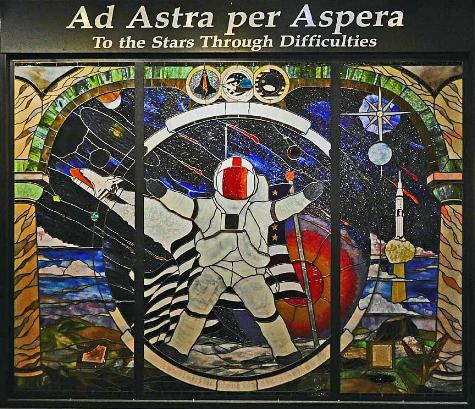 |
||||||||||||
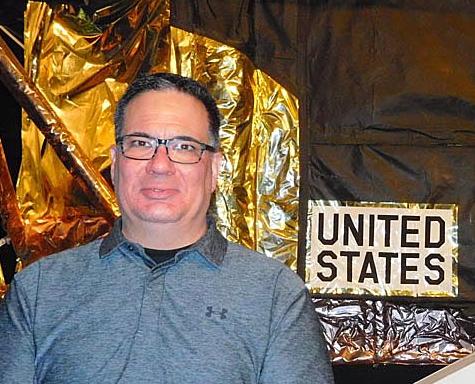 |
||||||||||||
Jim Remar, President and CEO of Cosmosphere. Behind Mr. Remar is the descent stage of a Lunar Module created by Grumman for Apollo lunar mission television coverage by NBC News. photos Michelle Evans |
||||||||||||
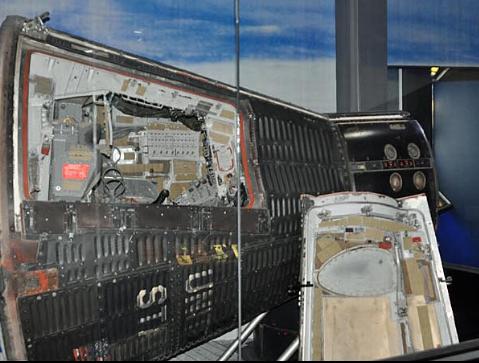 |
||||||||||||
The Gemini 10 spacecraft spent nearly 3 days in orbit 18-21 July 1966 with astronauts John Young and Michael Collins. |
||||||||||||
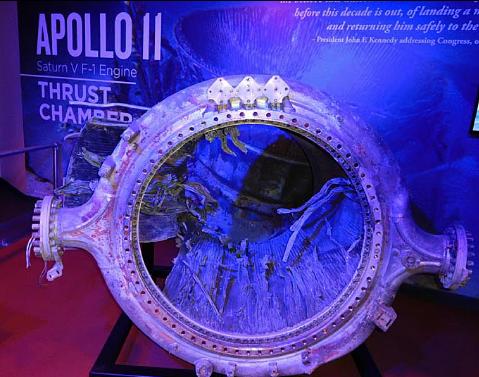 |
||||||||||||
A view of a thrust chamber from one of Apollo 11's five Saturn V first stage F-1 rocket engines. It was recovered from three miles below the surface of the Atlantic Ocean off the coast of Florida. At liftoff, each rocket produced 1.5 million pounds of thrust, for 7.5 million pounds total. |
||||||||||||
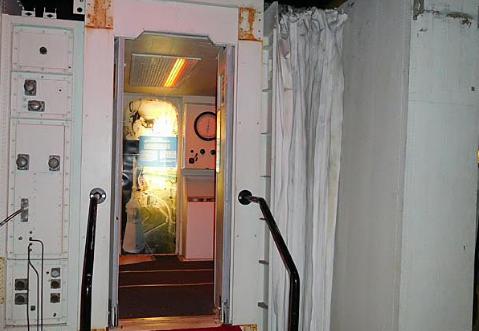 |
||||||||||||
This is the view Apollo astronauts saw as they proceeded down the Crew Access Arm into the White Room. |
||||||||||||
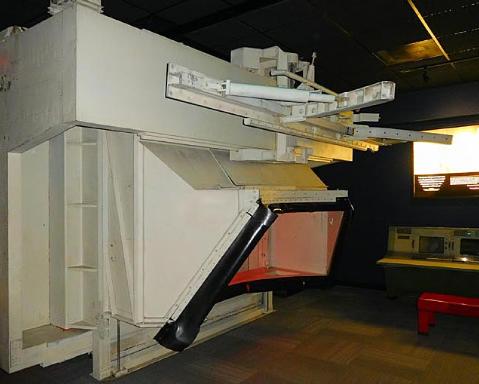 |
||||||||||||
Two views (above and below) of the White Room's exterior. The black trapezoidal opening was fitted snugly next to the side of the Apollo Command Module, allowing crew access through the spacecraft hatch. |
||||||||||||
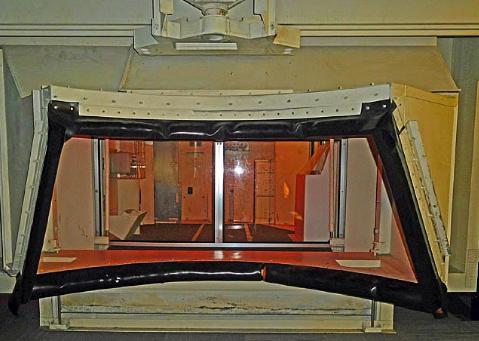 |
||||||||||||
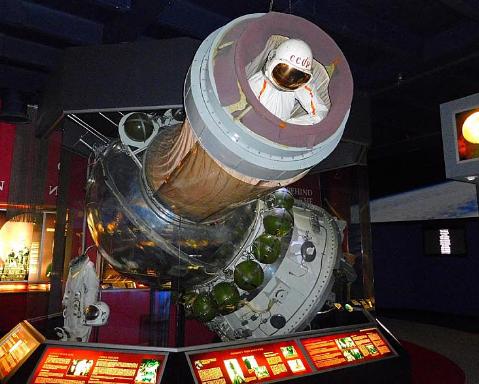 |
||||||||||||
Voskhod 2 mockup with inflatable airlock used by Alexei Leonov on the first human spacewalk, 18 March 1965. |
||||||||||||
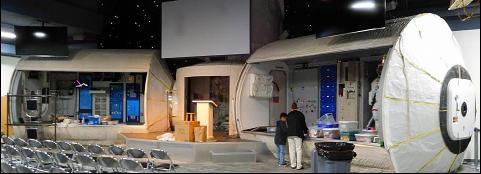 |
||||||||||||
Above: International Space Station simulator. Below: Soyuz trainer. |
||||||||||||
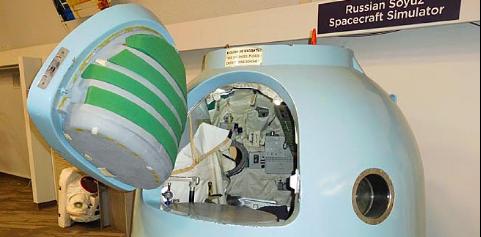 |
||||||||||||
Below are three Hasselblad film magazines that flew to the Moon and back: Gene Cernan, Commander, Apollo 17 Dave Scott, Commander, Apollo 15 Buzz Aldrin, Lunar Module Pilot , Apollo 11 |
||||||||||||
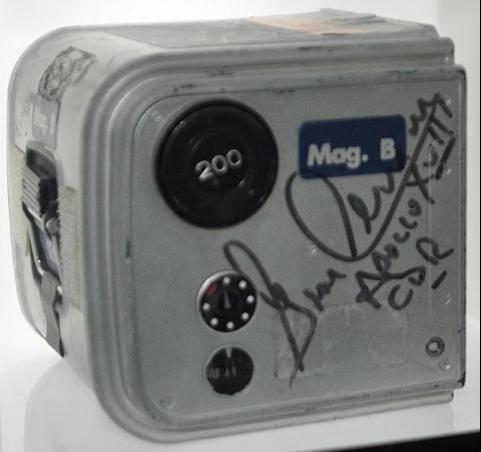 |
||||||||||||
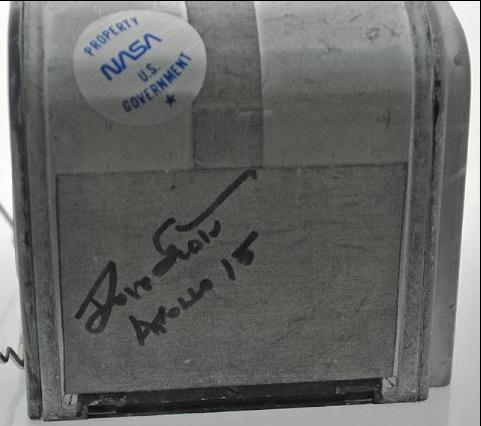 |
||||||||||||
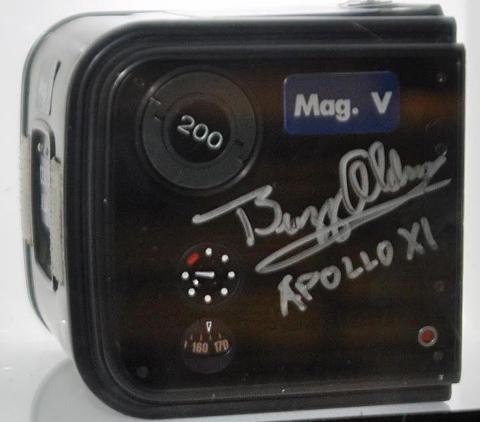 |
||||||||||||
 |
 |
 |
||||||